Thursday, May 24, 2012
Astronomy Cast Episode 234- Tunguska Event
On June 30th of 1908, as strange explosion occurred over the northern part of Siberia, north of Lake Baikal. Astronomers are unsure as to what exactly this event was or what it was caused by, however, it had a huge impact on Siberia and the area surrounding it. In fact, the explosion was heard in places so far away as Britain.
It wasn't until the 1920's that scientists began researching what had actually happened. On a trip to Siberia, scientists noticed much tree destruction in various intriguing patterns. At first, scientists thought that this was the cause of a meteor colliding with the Earth. However, on further inspection, they decided that a meteor was not large enough to create such widespread destruction. They were also unable to find a crater, which would have been formed, thus supporting that this was probably not the result of a meteor.
Instead, they began to believe that it could have been a comet that began to either melt, ionize, or just blow up as a result of entering Earth's atmosphere. They further determined that it must have been a comet sever meters in diameter, thus causing a big enough explosion to destroy what it did, but leave no crater. After testing some other theories, scientists verified that this theory is the most probable of all of them.
Zooniverse!
On zooniverse I have been able to identify 537 craters on the moon and classified 709 stars and galaxies. I hope this was enough for the blog post, I'm not completely aware of its requirements.
Tuesday, May 22, 2012
Observations Q4
At approximately 830 on 5/22/12 I was able to observe the Moon and Venus side by side. With binoculars I was even able to see the crescent shape of Venus. I was also able to see several spring constellations such as Ursa Major, Ursa Minor, Draco, Leo, Virgo, Canis Minor, Canis Major, Arcturus, and Sextans. I started observing around 8:30pm and stopped at 1130pm.
Monday, May 21, 2012
Jan Oort Biography

Jan Oort was a Dutch astronomer who made major contributions to our knowledge of the structure and rotation of the Milky Way Galaxy. Oort studied comets as well and provided evidence for his theory, now widely accepted, that the Sun is surrounded by a distant cloud of ice-rock objects that has become known as the Oort Cloud. Oort studied stellar dynamics under Jacobus Kapteyn at Groningen and worked at the University of Leiden from 1924 to 1992. In 1927 he confirmed Bertil Lindblad's hypothesis of galactic rotation by analyzing motions of distant stars through red and blue shifts. At this time Oort was also able to calculate that the Earth is 5900 parsecs from the center of the Galaxy. During World War II Oort started his compatriot Hendrik van de Hulst on the successful search for the 21-cm spectral line of neutral hydrogen and after the war led the Dutch group that used the 21-cm line to map the layout of the Galaxy, including the large-scale spiral structure, the galactic center, and gas-cloud motions. In 1950, based on his analysis of the well-measured orbits of 19 long-period comets, Oort proposed the existence of a vast repository of frozen cometary nuclei. The Oort cloud covers vast segments of space, starting somewhere between 2000 and 5000 AU from the sun with an outer boundary somewhere around 100,000 and 200,000 AU. He later showed that light from the Crab Nebula is polarized, confirming Iosif Shklovskii's suggestion that the emission is largely due to synchrotron radiation.
Sunday, May 20, 2012
Astronomy Cast Episode 225-Ice in Space
Many thing in our solar system are made of ice, for example, comets, rings, moons, and some dwarf planets. Recently, astronomers have asked the question, "where does all this ice come from?"
To begin, astronomy cast traveled to NASA to discuss plans involving the New Horizons mission, which plans to send spacecraft to the dwarf planet of Pluto, and beyond. This mission plans to capture images of many items in our solar system that are composed primarily of ice. They learned that there is a freeze line that exists somewhere in between Jupiter and Saturn, and once that line is crosses, ice becomes extremely evident in many celestial objects, such as the rings of Saturn. In the outer solar system, however, you enter a region where most objects are composed completely of ice, as opposed to partially made of ice.
We believe that many of these objects are formed where they currently exist, which explains and supports the existence of the freeze line. Parts of the Oort Cloud and Kuiper Belt are believed to have formed elsewhere, and were pulled into orbit by larger, stronger gravitational forces. Scientists have studied where and how the objects have formed. They have concluded that ice can form, not just from water, but from any molecule capable of vaporizing when exposed to extremely high temperatures. In the early solar system formed, the sun emitted many atoms and other such items, which eventually became solids once they reached the outer area of the solar system, where it was cold and the warmth of the sun had little effect.
Friday, May 18, 2012
APOD 4.8

A mere 2.5 million light-years away, the Andromeda Galaxy really is just next door as large galaxies go. So close, and spanning some 260,000 light-years, it took 11 different image fields from the Galaxy Evolution Explorer (GALEX) satellite's telescope to produce this gorgeous portrait of the spiral galaxy in ultraviolet light. While its spiral arms stand out in visible light images of Andromeda (also known as M31), the arms look more like rings in the GALEX ultraviolet view, dominated by hot, young, massive stars. As sites of intense star formation, the rings have been interpreted as evidence Andromeda collided with its smaller neighboring elliptical galaxy M32 more than 200 million years ago. The large Andromeda galaxy and our own Milky Way are the dominant members of the local galaxy group.
Monday, May 14, 2012
Wednesday, May 9, 2012
Observations Q4
through out the course of a single night I was able to see Ursa Major known commonly as the big dipper, Leo, Lynx, virgo, libra, ohpiuchus, bootes, what appeared to be hydra, hercules, draco, ursa minor, cephius, lyra, cancer, canis major, and libra.
Sunday, May 6, 2012
APOD 4.7
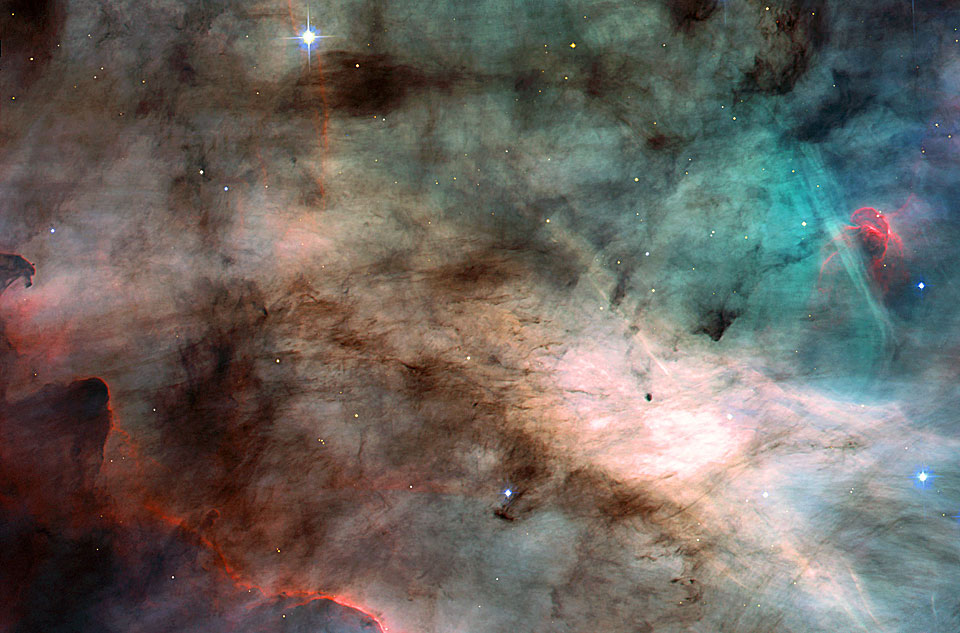
In the depths of the dark clouds of dust and molecular gas known as the Omega Nebula, stars continue to form. The above image from the Hubble Space Telescope's Advanced Camera for Surveys shows exquisite detail in the famous star-forming region. The dark dust filaments that lace the center of Omega Nebula were created in the atmospheres of cool giant stars and in the debris from supernova explosions. The red and blue hues arise from glowing gas heated by the radiation of massive nearby stars. The points of light are the young stars themselves, some brighter than 100 Suns. Dark globules mark even younger systems, clouds of gas and dust just now condensing to form stars and planets. The Omega Nebula lies about 5000 light years away toward the constellation of Sagittarius. The region shown spans about 3000 times the diameter of our Solar System.
Saturday, May 5, 2012
APOD 4.6

It was all lined up even without the colorful aurora exploding overhead. If you follow the apex line of the recently deployed monuments of Arctic Henge in Raufarhöfn in northern Iceland from this vantage point, you will see that they point due north. A good way to tell is to follow their apex line to the line connecting the end stars of the Big Dipper, Merak and Dubhe, toward Polaris, the bright star near the north spin axis of the Earth projected onto the sky. By design, from this vantage point, this same apex line will also point directly at the midnight sun at its highest point in the sky just during the summer solstice of Earth's northern hemisphere. In other words, the Sun will not set at Arctic Henge during the summer solstice in late June, and at its highest point in the sky it will appear just above the aligned vertices of this modern monument. The above image was taken in late March during a beautiful auroral storm.
Tuesday, April 24, 2012
APOD 4.5
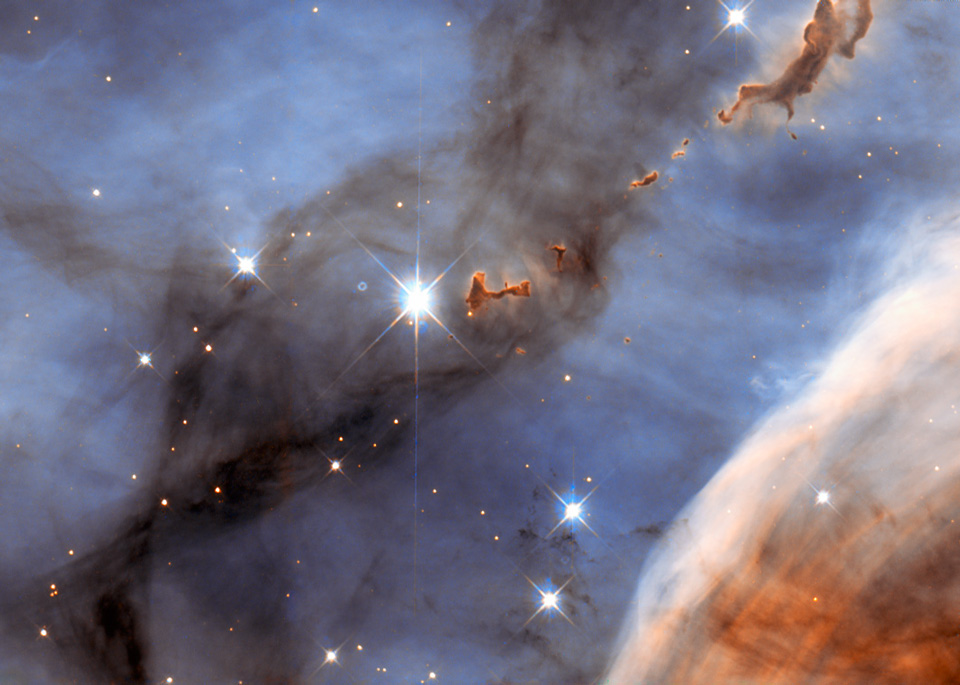
No, they are not alive -- but they are dying. The unusual blobs found in the Carina nebula, some of which are seen floating on the upper right, might best be described as evaporating. Energetic light and winds from nearby stars are breaking apart the dark dust grains that make the iconic forms opaque. Ironically the blobs, otherwise known as dark molecular clouds, frequently create in their midst the very stars that later destroy them. The floating space mountains pictured above by the orbiting Hubble Space Telescope span a few light months. The Great Nebula in Carina itself spans about 30 light years, lies about 7,500 light years away, and can be seen with a small telescope toward the constellation of Keel (Carina).
Friday, April 20, 2012
APOD 4.4

Except for the rings of Saturn, the Ring Nebula (M57) is probably the most famous celestial band. Its classic appearance is understood to be due to perspective - our view from planet Earth looks down the center of a roughly barrel-shaped cloud of glowing gas. But expansive looping structures are seen to extend far beyond the Ring Nebula's familiar central regions in this intriguing composite of ground based and Hubble Space Telescope images with narrowband image data from Subaru. Of course, in this well-studied example of a planetary nebula, the glowing material does not come from planets. Instead, the gaseous shroud represents outer layers expelled from the dying, once sun-like star at the nebula's center. Intense ultraviolet light from the hot central star ionizes atoms in the gas. Ionized oxygen atoms produce the characteristic greenish glow and ionized hydrogen the prominent red emission. The central ring of the Ring Nebula is about one light-year across and 2,000 light-years away. To accompany tonight's shooting stars it shines in the northern constellation Lyra.
Friday, April 13, 2012
apob 4.3

On another April 12th, in 1961, Soviet cosmonaut Yuri Alexseyevich Gagarin became the first human to see planet Earth from space. Commenting on his view from orbit he reported, "The sky is very dark; the Earth is bluish. Everything is seen very clearly". To celebrate, consider this recent image from the orbiting International Space Station. A stunning view of the planet at night from an altitude of 240 miles, it was recorded on March 28. The lights of Moscow, Russia are near picture center and one of the station's solar panel arrays is on the left. Aurora and the glare of sunlight lie along the planet's gently curving horizon. Stars above the horizon include the compact Pleiades star cluster, immersed in the auroral glow.
Thursday, April 5, 2012
apod 4.2

Sweeping from the eastern to western horizon, this 360 degree panorama follows the band of zodiacal light along the solar system's ecliptic plane. Dust scattering sunlight produces the faint zodiacal glow that spans this fundamental coordinate plane of the celestial sphere, corresponding to the apparent yearly path of the Sun through the sky and the plane of Earth's orbit. The fascinating panorama is a mosaic of images taken from dusk to dawn over the course of a single night at two different locations on Mauna Kea. The lights of Hilo, Hawaii are on the eastern (left) horizon, with the Subaru and twin Keck telescope structures near the western horizon. On that well chosen moonless night, Venus was shining as the morning star just above the eastern horizon, and Saturn was close to opposition. In fact, Saturn is seen immersed in a brightening of the zodiacal band known as the gegenschein. The gegenschein also lies near 180 degrees in elongation or angular distance from the Sun along the ecliptic. In the mosaic projection, the plane of our Milky Way Galaxy runs at an angle, crossing the horizontal band of zodiacal light above the two horizons. Nebulae, stars, and dust clouds of the bulging galactic center are rising in the east.
Friday, March 30, 2012
apod 4.1
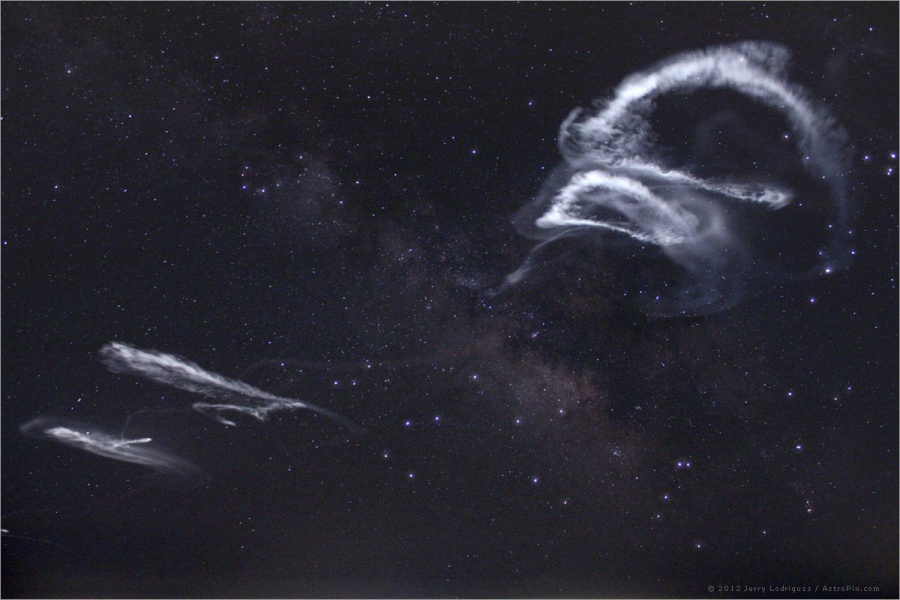
On March 27, five sounding rockets leapt into early morning skies from NASA's Wallops Flight Facility in Virginia. Part of the Anomalous Transport Rocket EXperiment (ATREX), begining at 4:58 am EDT the rockets launched consecutively at 80 second intervals. Releasing a chemical tracer they created luminous white clouds within Earth's ionosphere at altitudes above 60 to 65 miles, swept along by the poorly understood high-altitude jet stream. (Not the same jet stream that airliners fly through at altitudes of 5 to 6 miles.) Seen along the mid-atlantic region of the United States, the clouds drifted through starry skies, captured in this clear photograph from East Point, New Jersey. Looking south toward the launch site, the tantalizing celestial background includes the stars of Sagittarius, Scorpius, and the more permanent faint, white, luminous clouds of the Milky Way.
Wednesday, March 21, 2012
SNR

SN 106
Visible after May 1st, 1006 with an appearent magnatude of -7.5 it could have easily been seen all around the globe.

SN 1054
Visible 1054 CE with an appearent magnatude of -6. This stringy super nova was 6,300 Lightyears away.

SN 1181
Visible during 1181 CE, SN 1181 had an apparent magnitude of -1 and is at least 26,000 light years away. Possibly the remnant of a pulsar.
Sunday, March 18, 2012
apod 3.8
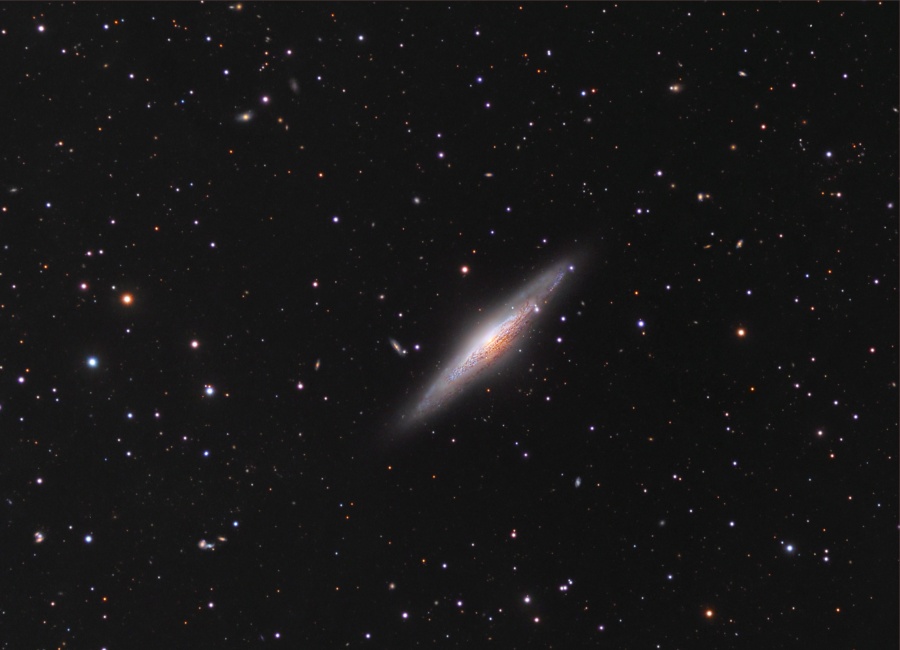
Here the island universe, NGC 2683 is cataloged in an artful manor. At 16 million light years away, it is one of the closest galaxies to our own. This photo artfully captures the spiral shape of this galaxy. The light it produces is thought to be from a blend of the light from countless old yellow-ish stars, which are packed extremely densely in the galactic core. This is probably one of my favorite images that I've seen so far on astronomy picture of the day, if nothing else for the amazing aperture. The outer segments of the rings clearly contain a lot of cosmic dust. The image was able to be so clear due to the use of a powerful refracting telescope with internal supports.
Friday, March 16, 2012
Observation 4.1
walking
exploring
hunting late at night
seeking
for knowledge
of the unknown sky
ideas
expanding
from my mind
in
the sky
stars
and constellations
could
be seen
Leo; the lion
Ursa Major and minor; the great bears
Canis Major; the dog
Canis Minor; the little dog
Sirius and Procyon
The Sextans all across the sky
Virgo, The Virgin
Gemini; The Twins
Castor and Pollux
all on the zodiac
Orion, The hunter, Betelgeuse, and Rigel
Columba and Lepus the Dove and the Hair
watching the sky, all night long
exploring
hunting late at night
seeking
for knowledge
of the unknown sky
ideas
expanding
from my mind
in
the sky
stars
and constellations
could
be seen
Leo; the lion
Ursa Major and minor; the great bears
Canis Major; the dog
Canis Minor; the little dog
Sirius and Procyon
The Sextans all across the sky
Virgo, The Virgin
Gemini; The Twins
Castor and Pollux
all on the zodiac
Orion, The hunter, Betelgeuse, and Rigel
Columba and Lepus the Dove and the Hair
watching the sky, all night long
Friday, March 9, 2012
apod 3.7
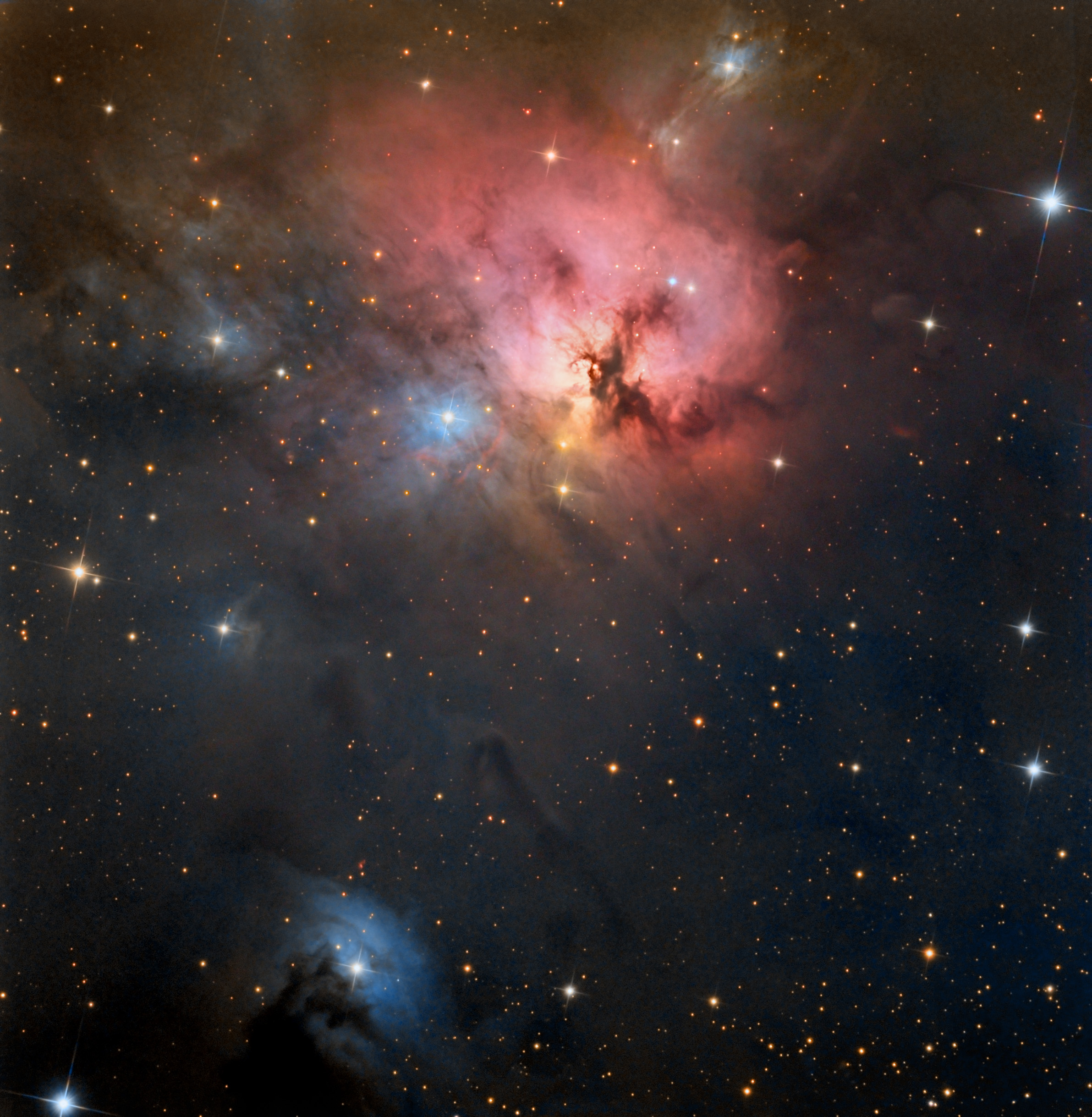
Colorful NGC 1579 resembles the better known Trifid Nebula, but lies much farther north in planet Earth's sky, in the heroic constellation Perseus. About 2,100 light-years away and 3 light-years across, NGC 1579 is, like the Trifid, a study in contrasting blue and red colors, with dark dust lanes prominent in the nebula's central regions. In both, dust reflects starlight to produce beautiful blue reflection nebulae. But unlike the Trifid, in NGC 1579 the reddish glow is not emission from clouds of glowing hydrogen gas excited by ultraviolet light from a nearby hot star. Instead, the dust in NGC 1579 drastically diminishes, reddens, and scatters the light from an embedded, extremely young, massive star, itself a strong emitter of the characteristic red hydrogen alpha light.
Sunday, March 4, 2012
observation q3
obersvationing on friday 3/4/12
~ 7 i saw jupiter mercury and venus all lined up super cool and mercury was really red and dim
later that night i saw a bunch of constellations like all of them. canus major and minor, orion, gemeni, sirius, columba, lepus, taurus, and auriga
~ 7 i saw jupiter mercury and venus all lined up super cool and mercury was really red and dim
later that night i saw a bunch of constellations like all of them. canus major and minor, orion, gemeni, sirius, columba, lepus, taurus, and auriga
Friday, March 2, 2012
apod 3.6
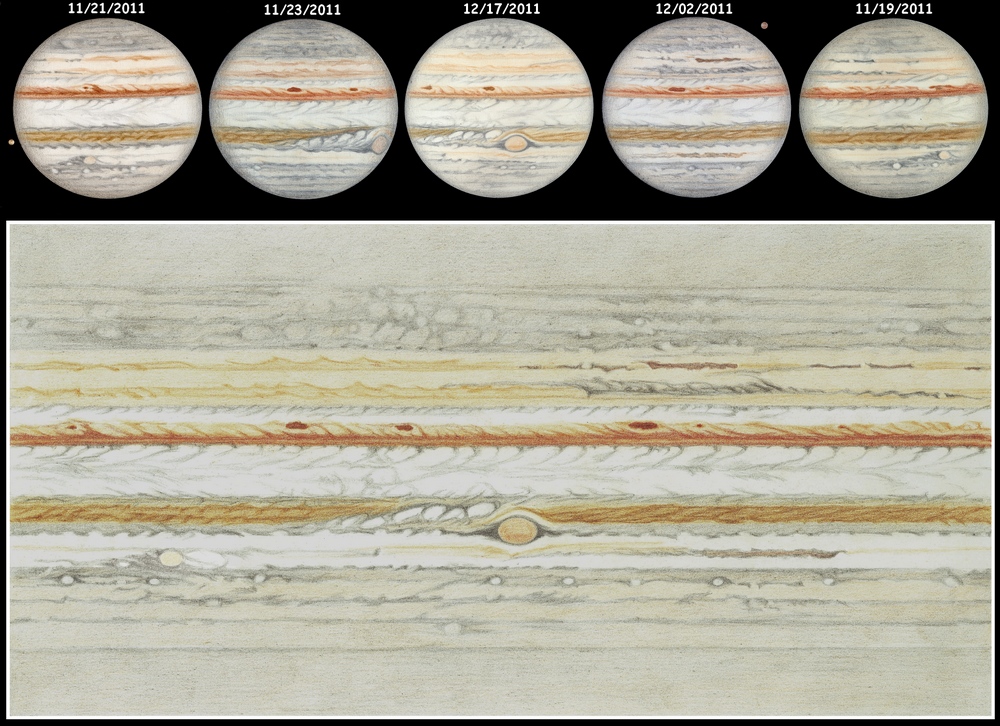
Five hand drawn sketches of Jupiter were used to create this beautifully detailed flat map of the ruling gas giant's turbulent cloud tops. Made with colored pencils at the eyepiece of a 16 inch diameter telescope, the original drawings are about 5 inches (12.5 cm) in diameter. The drawn planisphere map dimensions are 16x8 inches (40x20 cm). Observing on different dates in November and December of 2011, astronomical artist Fred Burgeot has relied on Jupiter's rotation to cover the planet's complete circumference. Digital animator Pascal Chauvet has also translated Burgeot's drawings into an intriguing video (vimeo), synthesizing a telescopic view of the rotating planet with a tilt and phase appropriate for the observing dates. The video includes the Galilean moons moving along their orbits, beginning with Ganymede and Io casting shadows as they glide in front of Jupiter, followed by Europa and Callisto passing behind the planet's banded disk.
Saturday, February 25, 2012
George E Halel Biography
George Ellery Hale was an American astronomer who pioneered in the development of instruments for studying the sun. He also planned the construction of several giant telescopes, including the Hale Reflecting Telescope at the Palomar Oberservatory near San Diego. This instrument has a diameter of 200 inches.
Hale was Born in Chicago in 1868 and graduated from the Massachusestts Insitute of Technology. in 1891, he introduced the spectroheliograph, an instrument that enables astronomers to photograph the surface of the sun with light of a single wavelength. Photographs made with a spectroheliograph reveal the distribution on the sun's surface of such elements as calcium, hydrogen, and iron. Hale also made important discoveries about sunspots. For example, he proved that these dark areas on the sun have strong magnetic fields. In 1895, Hale, along with Joseph Keeler, founded the Astrophysical Journal, which became the leading journal for astronmers. Hale founded and served as first director of the Yerkes Observatory in Wisconsin and , later, the Mount Wilson Observatory in California. Hale retried as editor of the Astrophysical Journal in 1934, and died in 1938.

A spectroheliography of the Sun at 195 angstroms, the color of iron.
Hale was Born in Chicago in 1868 and graduated from the Massachusestts Insitute of Technology. in 1891, he introduced the spectroheliograph, an instrument that enables astronomers to photograph the surface of the sun with light of a single wavelength. Photographs made with a spectroheliograph reveal the distribution on the sun's surface of such elements as calcium, hydrogen, and iron. Hale also made important discoveries about sunspots. For example, he proved that these dark areas on the sun have strong magnetic fields. In 1895, Hale, along with Joseph Keeler, founded the Astrophysical Journal, which became the leading journal for astronmers. Hale founded and served as first director of the Yerkes Observatory in Wisconsin and , later, the Mount Wilson Observatory in California. Hale retried as editor of the Astrophysical Journal in 1934, and died in 1938.

A spectroheliography of the Sun at 195 angstroms, the color of iron.
Saturday, February 18, 2012
apod 3.5
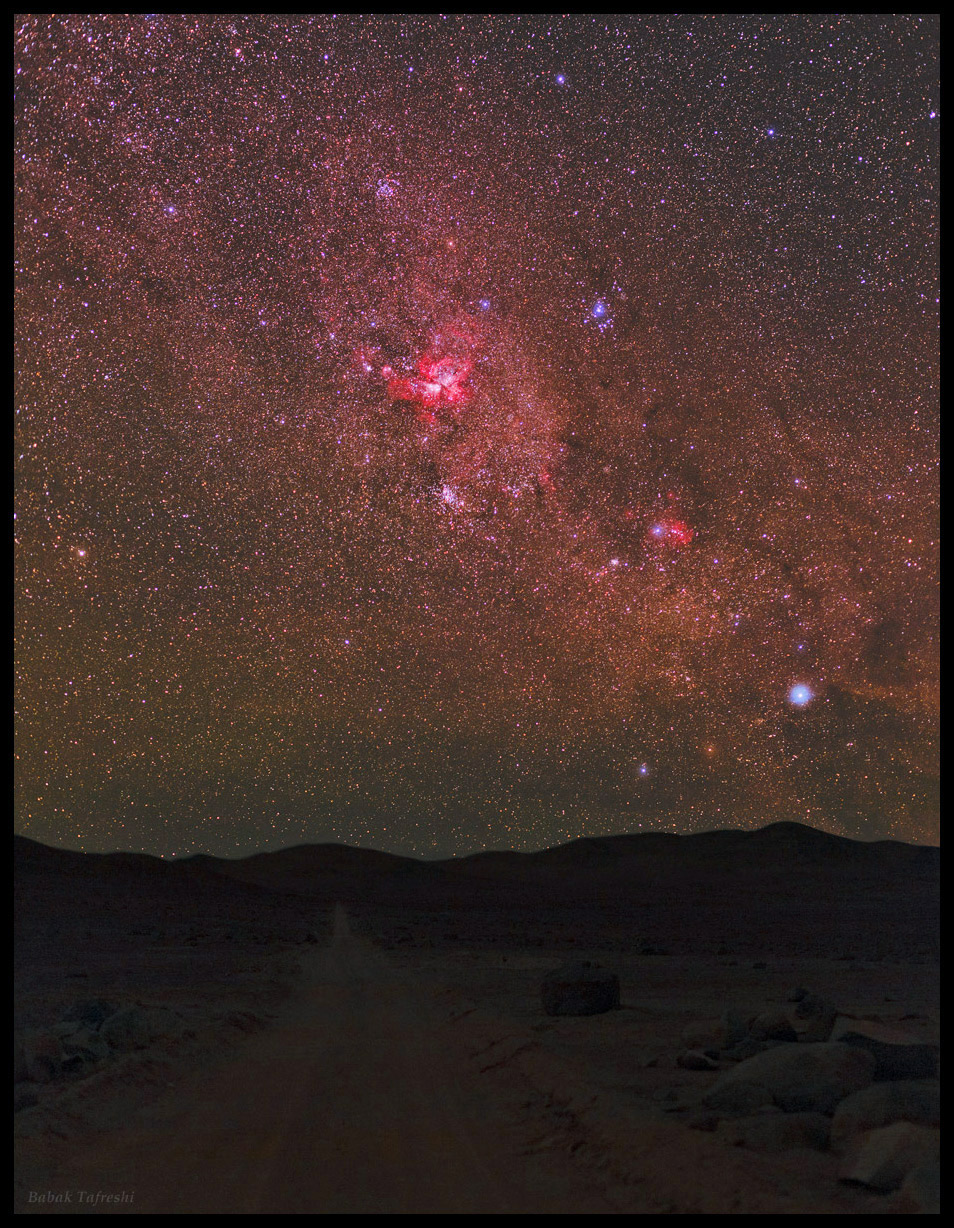
This rugged road through the dark Atacama Desert seems to lead skyward toward the bright stars and glowing nebulae of the southern Milky Way. If you follow the road you will get to Cerro Armazones peak in Chile, future construction site for the 40-meter class European Extremely Large Telescope. For now though, sliding your cursor across the image will identify wonders of the southern skies in view. The scene is dominated by the reddish glow of the Great Carina Nebula, one of our galaxy's largest star forming regions. In fact, the remarkable skyscape is not a composite of varying exposures or a photomontage. Far from sources of light pollution, the landscape illuminated by starlight and the Milky Way above were recorded by a modified digital camera and fast lens. The sensitive system captured both planet Earth and deep sky in a relatively short exposure.
Thursday, February 16, 2012
George E Hale Biography Bibliography
Tenn, Joseph. "The Bruce Medalists: George Ellery Hale." SSU Department of Physics & Astronomy - Home. Sonoma.edu. Web. 4 Feb. 2012. <http://www.phys-astro.sonoma.edu/brucemedalists/hale/>.
ID1223361683. "Who Was George E Hale and What Did He Discover." The Q&A Wiki. Wiki Answers, 5 Aug. 2009. Web. 16 Feb. 2012. <http://wiki.answers.com/Q/Who_was_George_E_Hale_and_what_did_he_discover>.
Osterbrock, D. E. "Founded in 1895 by George E. Hale and James E. Keeler: The Astrophysical Journal Centennial." SAO/NASA ADS: ADS Home Page. Astrophysical Journal V.438, P.1, 1995. Web. 16 Feb. 2012. <http://adsabs.harvard.edu/full/1995ApJ...438....1O>.
"George Ellery Hale: Acknowledgement." The Franklin Institute - Home - 215.448.1200. Web. 16 Feb. 2012. <http://www.fi.edu/learn/case-files/hale-2863/reward.html>.
"Dr. George E. Hale, Astronomer, Dead." The New York Times - Breaking News, World News & Multimedia. NyTimes. Web. 16 Feb. 2012. <http://www.nytimes.com/learning/general/onthisday/bday/0629.html>.
ID1223361683. "Who Was George E Hale and What Did He Discover." The Q&A Wiki. Wiki Answers, 5 Aug. 2009. Web. 16 Feb. 2012. <http://wiki.answers.com/Q/Who_was_George_E_Hale_and_what_did_he_discover>.
Osterbrock, D. E. "Founded in 1895 by George E. Hale and James E. Keeler: The Astrophysical Journal Centennial." SAO/NASA ADS: ADS Home Page. Astrophysical Journal V.438, P.1, 1995. Web. 16 Feb. 2012. <http://adsabs.harvard.edu/full/1995ApJ...438....1O>.
"George Ellery Hale: Acknowledgement." The Franklin Institute - Home - 215.448.1200. Web. 16 Feb. 2012. <http://www.fi.edu/learn/case-files/hale-2863/reward.html>.
"Dr. George E. Hale, Astronomer, Dead." The New York Times - Breaking News, World News & Multimedia. NyTimes. Web. 16 Feb. 2012. <http://www.nytimes.com/learning/general/onthisday/bday/0629.html>.
Sunday, February 12, 2012
observation 3
Starting my observations in the early evening, I saw venus and jupiter within 30 degrees of eachother right around sunset. I was able to see Orion, Canis Major, Taurus, the Pleiades, and Gemini in the southern Sky. In the northern sky I could see Cephius and Ursa Minor
apod 3.4
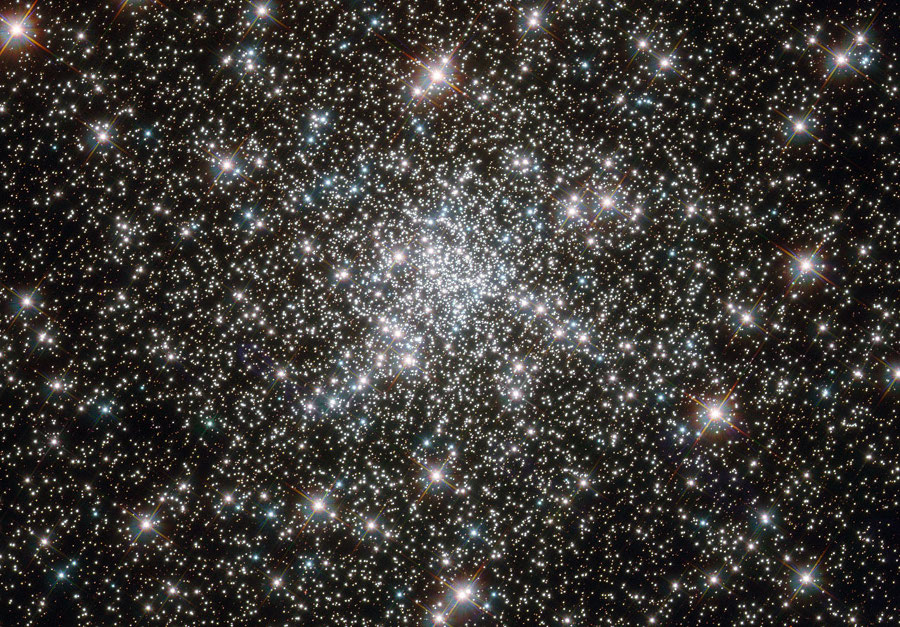
Hubble Deep field images can peer deep into the universe, and that's exactly what its doing in this image of NGC 6752. Located 13,000 away in the southern constellation of Pavo. For a 10 billion year old cluster with hundreds of thousands of stars, it has a lot of blue stars, especially in its core. These blue stars are too young to have been formed with the rest of the cluster, so its thought that they were formed by the collision of two or more red stars, as multistar systems are extremely common in this cluster.
Friday, February 3, 2012
APOD 3.3
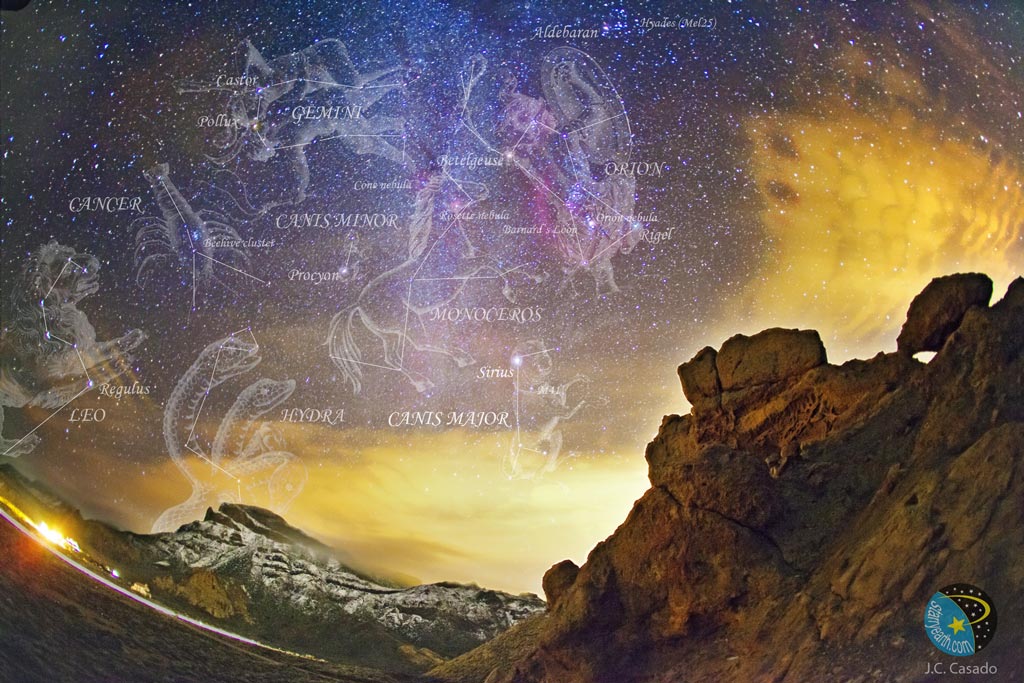
Over the rocky peaks in Teide National Park on Tenerife Island of the Spanish Canary Islands off the northwestern coast of Africa. The volcanic landscape features old island summits and is sometimes used as a testbed for instruments on future Martian rovers. The light of nearbye civilization can be seen in the bottom corner of the shot. The red ring in Orion's belt is Barnards Loop. To achive this level of clarity the camera was over exposed.
Friday, January 27, 2012
APOD 3.2
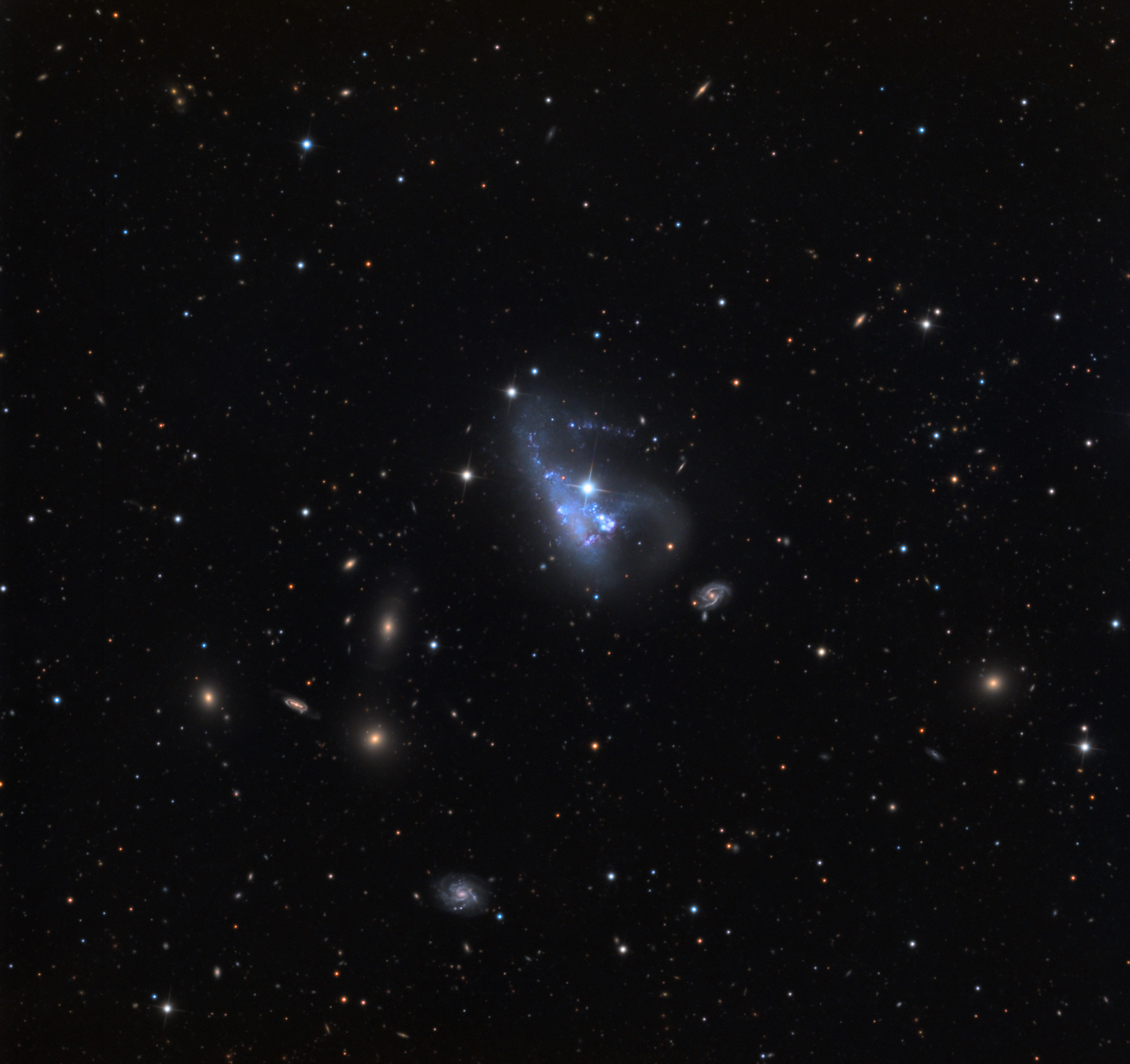
About 40,000 light-years across, pretty, irregular galaxy NGC 3239 lies near the center of this lovely field of galaxies in the galaxy rich constellation Leo. At a distance of only 25 million light-years it dominates the frame, sporting a peculiar arrangement of structures, young blue star clusters and star forming regions, suggesting that NGC 3239 (aka Arp 263) is the result of a galaxy merger. Appearing nearly on top of the pretty galaxy is a bright, spiky, foreground star, a nearby member of our own Milky Way galaxy almost directly along our line-of-sight to NGC 3239. Still, NGC 3239 is notable for hosting this year's first confirmed supernova, designated SN 2012A. It was discovered early this month by supernova hunters Bob Moore, Jack Newton, and Tim Puckett. Indicated in a cropped version of the wider image, SN 2012A is just below and right of the bright foreground star. Of course, based on the light-travel time to NGC 3239, the supernova explosion itself occurred 25 million years ago, triggered by the core collapse of a massive star.
Friday, January 20, 2012
APOD 3.1

A Full Moon rising can be a dramatic celestial sight, and Full Moons can have many names. Captured on January 8 from Östersund, Sweden, this evocative moonrise portrait might make you feel the cold of winter in the north. If you can also imagine wolves howling in the distance then you probably understand why Native Americans would have called it the Wolf Moon, their traditional name for the first Full Moon in January. The photographer reports that no wolves were heard though, as he watched this beautiful Full Moon rise in fading light over the eastern horizon, echoing the yellow color of the setting Sun. Of course, due this year on February 7, the next Full Moon will be the Snow Moon.
Monday, January 16, 2012
Johann Heinrich von Mädler Biography
Orphaned at the age of 19, Johann Heinrich von Mädler was forced to raise his three younger siblings by becoming a private tutor. This allowed him to connect with the businessman William Beer, who would later give Mädler a job at his observatory in 1829. In 1930 Mädler began drawing surface maps of Mars. For the prime meridian of their map, he eventually chose the Sinus Meridiani formation. Using his maps and drawings of Mars, and his knowledge of math, Mädler was able to make a rough calculation of Mar's rotational period to within 13 seconds of the actual period of rotation.
Johann Heinrich von Mädler was also one of the first people to make an accurate surface map of the moon, which he published with descriptions in four volumes from 1834 to 1836. His singular efforts to map these celestial bodies should not go forgotten in the sands of time, as he was one of the most important astronomers of the 19th century, not only because of the maps he drew, but because of the accuracy of his calculations of the orbital period of Mars.

Johann Heinrich von Mädler was also one of the first people to make an accurate surface map of the moon, which he published with descriptions in four volumes from 1834 to 1836. His singular efforts to map these celestial bodies should not go forgotten in the sands of time, as he was one of the most important astronomers of the 19th century, not only because of the maps he drew, but because of the accuracy of his calculations of the orbital period of Mars.
Friday, January 13, 2012
APOD 2.8 - Iapetus
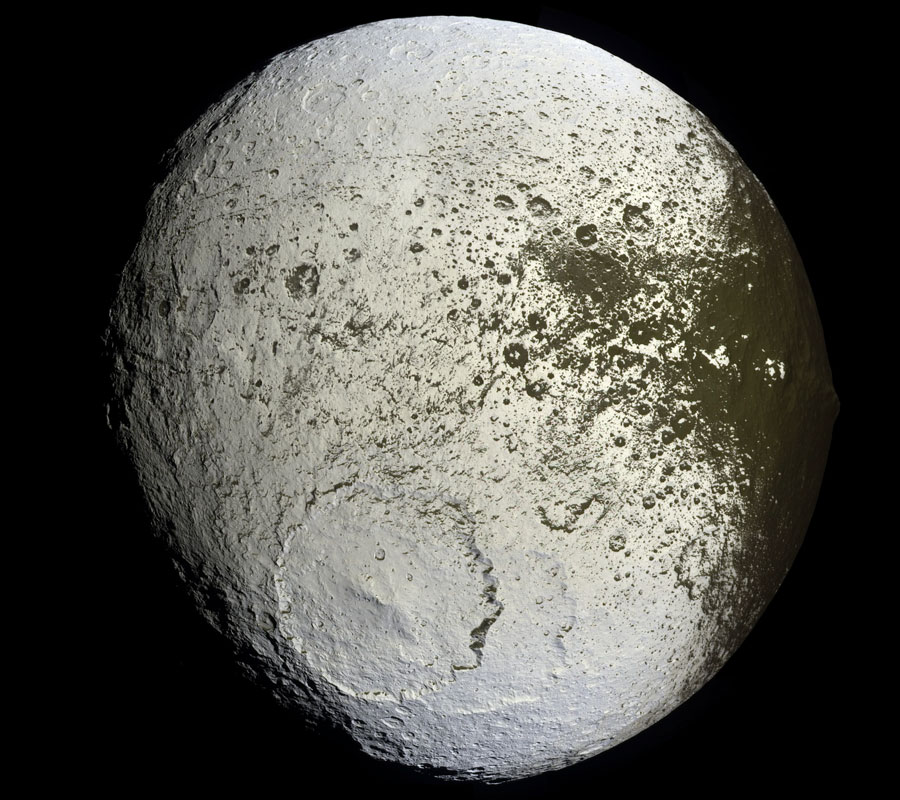
Saturns moon Iapetus is a vast frozen world, much of it is covered in ice while the rest of it is a mysterious dark material is of unknown composition. But infrared spectroscopy indicates that it could contain some form of carbon. Iapetus has a strange equatorial ridge that makes it look like a walnut. To help better understand Iapetus NASA sent the Cassini to orbit within 2,000 kilometers of the moon in 2007. It is thought that the dark parts of the moon are less than a meter thick and was formed when dirty ice sublimated.
Friday, January 6, 2012
APOD 2.7

5,000 light years across and located 2.3 million light years away in the northern boundaries of Cassiopeia IC 10 is young irregualr dwarf galaxy. It is still very young and there is lots of dust in the galaxy that blocks large portions of the light it produces. The redness of the dust shows that it is made of young stars and still full of vigorous star formation. IC 10 is the closest known starburst galaxy and has a large population of young, large, and extremely luminous stars.
Thursday, January 5, 2012
bibliography
http://go.galegroup.com/ps/retrieve.do?sgHitCountType=None&sort=RELEVANCE&inPS=true&prodId=GVRL&userGroupName=fl_sarhs&tabID=T003&searchId=R1&resultListType=RESULT_LIST&contentSegment=&searchType=BasicSearchForm¤tPosition=1&contentSet=GALE%7CCX2830902750&&docId=GALE|CX2830902750&docType=GALE
http://en.wikipedia.org/wiki/Johann_Heinrich_von_M%C3%A4dler
http://go.galegroup.com/ps/retrieve.do?sgHitCountType=None&sort=RELEVANCE&inPS=true&prodId=GVRL&userGroupName=fl_sarhs&tabID=T003&searchId=R2&resultListType=RESULT_LIST&contentSegment=&searchType=BasicSearchForm¤tPosition=2&contentSet=GALE%7CCX1673900038&&docId=GALE|CX1673900038&docType=GALE
http://en.wikipedia.org/wiki/Johann_Heinrich_von_M%C3%A4dler
http://go.galegroup.com/ps/retrieve.do?sgHitCountType=None&sort=RELEVANCE&inPS=true&prodId=GVRL&userGroupName=fl_sarhs&tabID=T003&searchId=R2&resultListType=RESULT_LIST&contentSegment=&searchType=BasicSearchForm¤tPosition=2&contentSet=GALE%7CCX1673900038&&docId=GALE|CX1673900038&docType=GALE
Subscribe to:
Posts (Atom)
